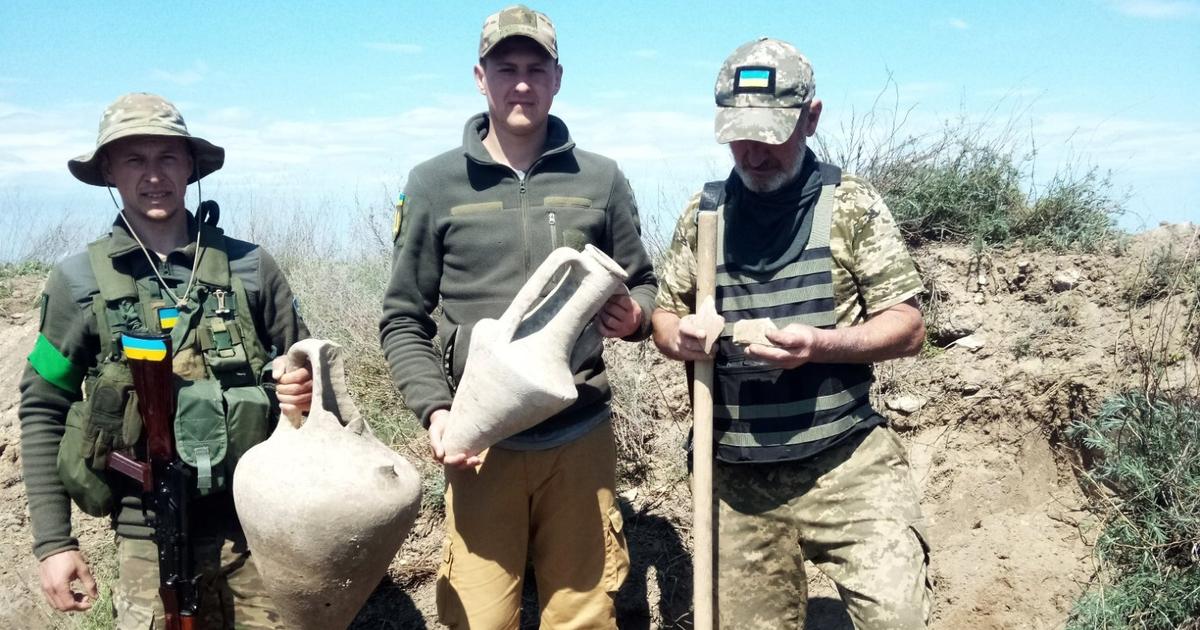Archaeologists do not have a monopoly on trenches and discoveries of ancient objects.
Busy fortifying the Odessa region since the beginning of the Russian invasion, Ukrainian soldiers from the 126th Territorial Defense Brigade were surprised to discover, at the end of their shovels, two potbellied and grayish ceramics, announced the management. of the unit, on May 11.
These were not scraps left behind by some contemporary and exacting potter, but much more precious possessions: antique amphoras.
To discover
Discover the “Best of the Goncourt Prize” collection
Read alsoPianist Valentina Lisitsa plays in the ruins of Mariupol, “liberated” by the Russians
These containers of Greek origin and dated to the 5th or 4th century BC.
AD do not compete with the painted vases of Etruscan tombs.
In common ceramics, devoid of the slightest decoration, these almost intact amphorae - one of them has lost a handle - are nevertheless a surprising find for the Ukrainian soldiers.
The precise area of this discovery was not indicated in the press releases of the 126th brigade.
The soldiers, however, said they discovered
“every day”
pottery shards, a sign of an archaeologically rich environment.
All the remains have been transferred to the Archaeological Museum of Odessa.
The two amphorae unearthed last week in the Odessa region are the best-preserved ancient remains discovered by Ukrainian Territorial Defense soldiers.
Odesa Territorial Defense's 126th Brigade
Ukrainian cultural heritage in danger
Due to the war, the ancient site disturbed by the trenches should not be studied anytime soon.
It could correspond to one of the colonies or of the many Greek counters and establishments of the North of the Black Sea, known in Antiquity under the name of Pont Euxin.
These amphorae, characterized in particular by the presence of two handles and a narrow foot, were used for the transport of liquid products, most often wine or oil.
The Greeks traded in it with the Sarmatians, the Cimmerians and in particular the Scythians who, like the Ukraine, provided a quantity of wheat.
Read alsoThe Scythian treasures of a Ukrainian museum looted by the Russian army
Even more than the fortification works, the intensity of the fighting in Ukraine poses a risk to the country's archaeological heritage.
The region of Izioum, from which the prehistoric Venus
of Willendorf could originate
, has thus become since April the scene of a bitter battle and massive bombardments between the Russian and Ukrainian armies.
Defensive works and other networks of trenches can also degrade or even destroy a precious archaeological context, like a clandestine excavation.
From the start of the invasion, on February 24, Unesco called on the two belligerents to respect the 1954 Hague Convention for the Protection of Cultural Property in the Event of Armed Conflict.
The world north of the Aegean Sea was well known to the ancient Greeks and formed the backdrop for part of the Argonauts' journey to Colchis, on present-day Georgian and Abkhazian coasts.
The old Odessa is more obscure.
It does not correspond to the ancient city of Odessos, which preceded present-day Varna, in Bulgaria.
The former occupation of the port was more modest.
Three sites dated from the 6th to the 3rd century BC.
were unearthed around Odessa Bay during Polish-Ukrainian excavations carried out in the 1990s. Habitats, necropolises and remains of Greek ceramics characterized these various coastal and commercial settlements.
As a prefiguration of the port that posterity would nickname, a few centuries later,






